The bullets whizz by
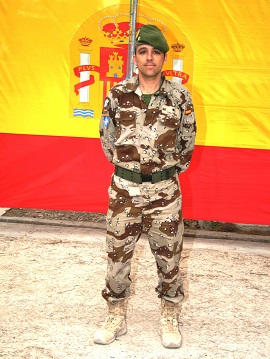
It is 5.38 am on the morning of 14th June 2000. The town of Khaikhane can be seen from the border. It is a sizzling night, one of those that grab the Afghan ground in June and do not set it free until autumn starts. The weight of the equipment (bulletproof vest, magazine pouches with all the magazines filled, helmet), and weapons, is multiplied by the heat and the night.
It is the last border. To the east, the town of Khaikhane, from which the Afghan Police will start the approach to the city centre, can be spotted. To the West, hidden in the shadows, the mouth of the valley can be seen, with the towns of Piwar and Darra-i-Bum at the back, ruled by insurgents. That is the place chosen for the deployment of the Tactical Control Air Detachment (TACP) and the section of the support element that goes with them, with the aim of controlling all the area, as well as securing the way back from a dominant position.
The mission, in support of the Afghan National Security Forces (ANSF), aims at identifying possible settlements to establish a Patrol Base for the Afghan Police in the Khaikhane area, contributing to reach the necessary security and stability that can make reconstruction possible. The continuous attacks by the insurgents are turning the life of the inhabitants of the province of Bagdhis into a nightmare.
It is not just another mission. They must enter the town by ways almost impossible to walk along.
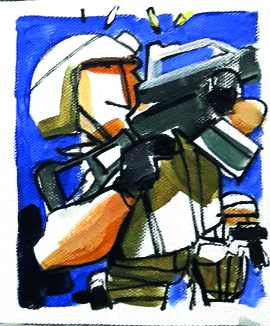
It is not just another mission. They must enter the town of Khaikhane. However, they cannot do it through its two natural passes, from the north and south areas of the valley, but through these ways that are almost impossible to walk along, since their steep slopes and their narrow paths drawn by fleeting torrents become small geographical arteries that can hardly be used. Major Jose Ignacio Valverde knows it is crucial to conduct the operation by surprise, changing the way of doing it, and specially the moment, since it is necessary to reach the area before the dawn. By doing so, they can prevent the enemy from attacking from advantageous positions in a land that is favourable for them, due to their greater mobility and knowledge.
Hours before, Major Valverde, who is in command of the Unit for Liaison and Observation (UEO), has received the order to head to Khaikhane with the reinforcements of the aforementioned TACP, three vehicles from the Company for Protection and Security, a sapper for IED (improvised explosive devices) reconnaissance, an interpreter and a mechanic. The Unit for Liaison and Observation, with twelve components from the Special Operations Command, goes at the forefront, followed by three Protection and Security vehicles.
Nobody is oblivious to the fact that the night surrounds them, but the starless sky, exclusively for them, can be a good ally.
In support of the Afghan police coming from Qades, that is appoaching the town of Khaikhane from the East, the column takes a path leading down, rigorous in its shape and resistent to the movement. Nobody is oblivious to the fact that the night surrounds them, and they even have to make a 40-minute stop on the way out of Qades since there is not even the minimum light intensity for helicopters to fly, in the face of a potential medical evacuation. They all know that the dark night, with a light that is lacking stars exclusively for them, is a good ally.
As they approach the border, the first attacks begin. The bullets whistle. A shy wind cannot manage to cool down the more than 15-kilo weight of the equipment. The rearguard of the column receives shots from RPG grenades. The soldiers' faces are serious, as the way becomes increasingly difficult in movement and manoeuvres, as a consequence of the steep slopes the vehicles must face.
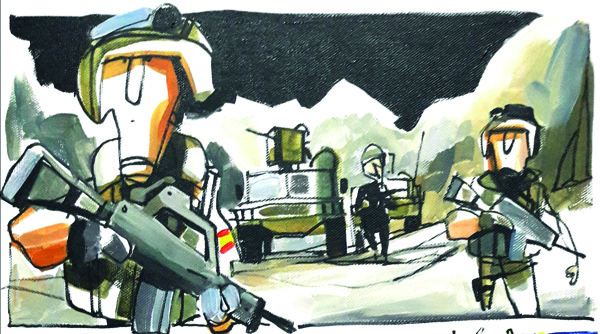
Meanwhile, the vanguard receives fire from enemy positions in the urban centre. The ANSF, together with the Spanish Army, is trying to free the city from the insurgents. Until then, safety was in the hands of tribal leaders, and the communication routes were controlled by warlords. They intend to revert this situation with the expansion of the Afghan state action over the whole province by establishing police stations.
The rearguard receives fire from grenades. The vanguard begins to receive it too, as well as fire from machine guns, from the insurgents positioned in the city centre. Major Valverde is informed that the units in the border are fighting against the insurgents, which implies that the vehicles in the column are under enemy fire, and what is worse, with no possibility of manoeuvring in favour of one another. They all stay calm. This calm is possible due to permanent training, a field in which the Special Operations Command is an expert.
They are told not to shoot, unless the origin of the attacks is clearly located, in order not to damage the civilian population. More often than not, the insurgents would use the civilians as a parapet, without any respect for their lives.
The two light machine guns of the UEO are looking for a position in the Western part of the border, as far as they allowed by the land, under Captain Marín's command.
The bullets whistle with a never-ending sound, as if the same projectile would go around the world and back to the fight, renewed in strength and effort. They all are receiving fire and responding to it, in a determined and calm answer.
Eventually, the weapons settle. The first is placed to the vanguard, more exposed to fire but in a crucial position, and shot by Sergeant Fernández. The other is located to the West, and shot by Corporal Calcerrada. The combat shrouds the ground, soldiers and means, regardless of reasons or circumstances.
The machine guns and soldiers do not rest. The bullets whistle. A shy wind cannot manage to cool down the more than 15-kilo weight of the equipment. At that moment they are people who were born to fight against the four elements: earth, air, water and fire. The bullets whistle.
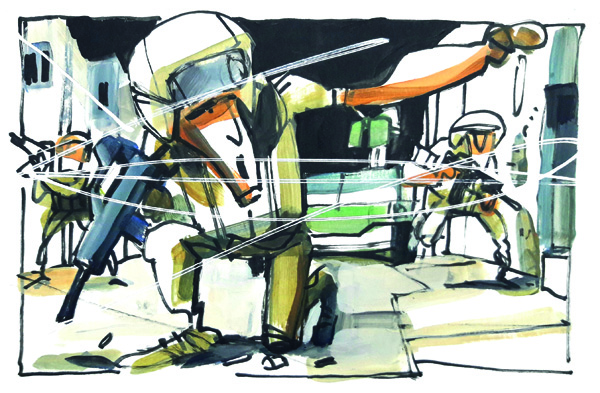
Once they are done with the immediate threat from the Western riverbed, after the hard fights, Major Valverde commands the first two vehicles from the Unit for Liaison and Observation to reach the position where the second light machine gun is placed. By doing so, the presence of the two heavy machine guns from the VAMTAC supports the positions to the North and provides an observation post from which the shot of all weapons from the Reconnaissance Section can be coordinated and corrected.
There is neither past nor future, just a great present alive in each movement, leap, step and order.
The Major decides to leave the two vehicles from the Protection and Security Company assuring the withdrawal of the Afghan police towards support positions. They all have dry dust stuck in their skin, their faces, their hands, the back of their necks. Meanwhile, the bullets whistle, and the shy wind cannot manage to cool down the more than 15-kilo weight of the equipment.
During the whole action, the origins of the fire in the enemy strongholds are defeated. Support to the fire in movement is extremely efficient in this language of steel and iron that never loses its voice in the battle.
As the roar from the two Coalition planes can be heard, the observers see how the injured enemies are moved to the bazaar area, where the insurgent centre is, area the ANSF must go to.
After several hours of fire and movement, when they realise they cannot defeat the Spanish solders, the Taliban insurgents withdraw from their positions.
The Police reaches the Western area where the bazaar is located in order to support the retreat and make the population feel that the Afghan forces are the ones freeing them from the insurgents. The enemy hardly offers resistance now.
As two F-15 fly attacking the last enemy positions outside the town, the units from the operative organisation begin to retreat, following the planned route.
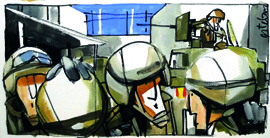
When they start the way back, Major Valverde receives the news that no Spanish soldier has been hurt. Suddenly, he realises he is very thirsty, and drinks in a gulp the water still left in his Camelbak. Then he remembers they are there with the aim of providing a safe environment that allows sustainable stabilty that can be felt by the Afghan population. He realises that today all his soldiers have contributed to this stability risking their lives, and with exemplary behaviour.
It is three o´clock in the afternoon of 14th June 2008, and the mission finishes for the Reconnaissance Element, once they enter the Qala-I-Naw base, headquarters of the Provincial Reconstruction Team. With this action and the previous ones, the twelve components from the Special Operations Command were awarded for military bravery. Captain Marín and Sergeant Fernández were granted a distinction in the General Order.
Still, as they enter the base, the memories of bullets whistling and a shy wind that cannot manage to cool down the more than 15-kilo weight of the equipment remain.
ARMY UNITS
- Araba Álava |
- Albacete |
- Alicante |
- Almería |
- Asturias |
- Ávila |
- Badajoz |
- Barcelona |
- Burgos |
- Cáceres |
- Cádiz |
- Cantabria |
- Castellón |
- Ceuta |
- Ciudad Real |
- Córdoba |
- A Coruña |
- Cuenca |
- Girona |
- Granada |
- Guadalajara |
- Gipuzkoa |
- Huelva |
- Huesca |
- Islas Baleares |
- Jaén |
- León |
- Lleida |
- Lugo |
- Madrid |
- Málaga |
- Melilla |
- Murcia |
- Navarra |
- Ourense |
- Palencia |
- Las Palmas |
- Pontevedra |
- La Rioja |
- Salamanca |
- Segovia |
- Sevilla |
- Soria |
- Tarragona |
- Santa Cruz de Tenerife |
- Teruel |
- Toledo |
- Valencia |
- Valladolid |
- Bizkaia |
- Zamora |
- Zaragoza



